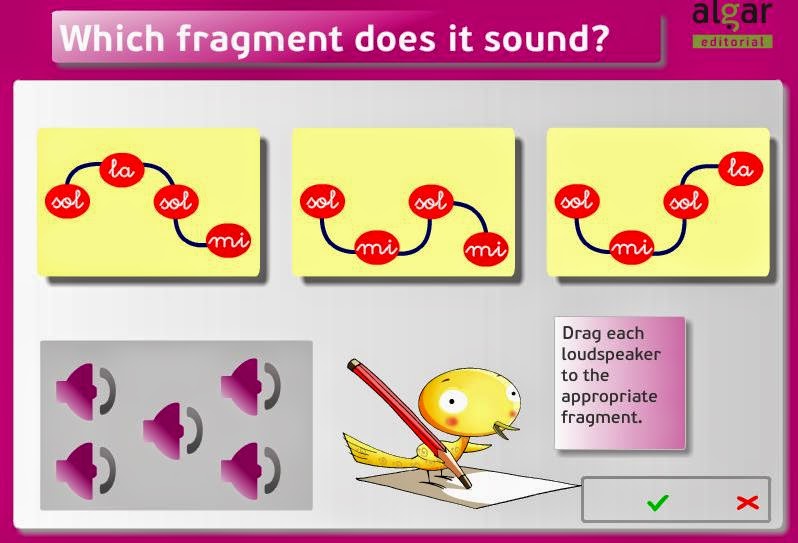La Fundación Ibercaja ha preparado un interesante material sobre la Historia de la música del S. XX y del Rock, con actividades, audiciones y otras propuestas.
Si os interesa, podéis descargarlo en el siguiente enlace:
miércoles, 11 de noviembre de 2015
miércoles, 4 de noviembre de 2015
¿Conoces line.do?
Desde la página de line.do podemos hacer líneas del tiempo de una forma fácil e intuitiva. Para comenzar solo debemos registrarnos, rellenando correo electrónico, nombre de usuario y contraseña:
Una vez registrados crear nuestra línea del tiempo es muy fácil, se elige categoría (educación, música...). Luego funciona de una forma similar al powerpoint. A la izquierda vamos añadiento hitos y por cada uno podemos poner fotos, vídeos o enlaces.
Desde la sección de Mi perfil podrás acceder a todas tus líneas del tiempo, ya estén en borrador o publicadas.
Una vez registrados crear nuestra línea del tiempo es muy fácil, se elige categoría (educación, música...). Luego funciona de una forma similar al powerpoint. A la izquierda vamos añadiento hitos y por cada uno podemos poner fotos, vídeos o enlaces.
Desde la sección de Mi perfil podrás acceder a todas tus líneas del tiempo, ya estén en borrador o publicadas.
lunes, 2 de noviembre de 2015
Music in Ancient Greece
The music of ancient Greece was almost universally present in society, from marriages and funerals to religious ceremonies, theatre, folk music and the reciting of epic poetry.
 |
| Musical instruments in Ancient Greece |
Ancient Greek musicians developed their own system of musical notation. Several complete songs exist in ancient Greek musical notation.
The Seikilos Epitaph is the oldest surviving example of a complete musical composition, including musical notation, from anywhere in the world.
Music was an important part in Education
Some Greek instruments are: the kithara, the aulos, syrinx and the lyre.
QUALITIES OF SOUND
|
DURATION
|
•
It produces short and long sounds
and fast and slow sounds.
•
Crotchet, minim, adagio, allegro...
|
|
PITCH
|
•
It is the relative highness or lowness that we hear in a sound
•
It produces high and low sounds
•
Scale, stave, keys...
|
|
DYNAMICS
|
•
It produces strong or soft sounds
•
ff,f,mf,p,pp, crescendo,
diminuendo
|
|
TONE
COLOR
or
TIMBRE
|
•
It enables us to distinguish
different instruments and
different voices.
|
miércoles, 28 de octubre de 2015
Games about Scheherezade
A GAME ABOUT SHEHEREZADE
Scheherezade is a musical work composed by the Russian composer Rimsky-Korsakov (1844-1908) |
| Rimsky-Korsakov |
You can listen to the composition, learn about the composer, read the plot and play the game in the following link:

lunes, 26 de octubre de 2015
miércoles, 16 de septiembre de 2015
martes, 15 de septiembre de 2015
jueves, 3 de septiembre de 2015
The (creepy) Magic Flute by Mozart
What do you think about this performance? Do you like it?
You can encourage your students to find adjectives to describe it:
You can encourage your students to find adjectives to describe it:
Polyrhythm exercises
Use your left and right hands to play these rhythms. You must play both lines at the same time.
Keep the rhythm by tapping on the table or by clapping on your knees:
martes, 14 de julio de 2015
lunes, 22 de junio de 2015
The little Mermaid - 'Under the sea' choreography
The original song:
You can also learn the song and practise with the lyrics:
The choreography:
domingo, 21 de junio de 2015
jueves, 18 de junio de 2015
martes, 16 de junio de 2015
lunes, 11 de mayo de 2015
miércoles, 22 de abril de 2015
lunes, 20 de abril de 2015
PERIODOS DE LA HISTORIA DE LA MÚSICA
Web dedicada a los distintos estilos de la historia de la música. Ofrece información fácil, visual y detallada sobre los distintos periodos de la música culta, así como audiciones que acompañan la explicación.
lunes, 6 de abril de 2015
miércoles, 11 de marzo de 2015
lunes, 2 de marzo de 2015
THE DIATONIC SCALE
- A scale is a set of notes ordered by pitch. It can be ascending or descending
- The diatonic scale is made of seven notes (high 'do' is repeated)
sábado, 28 de febrero de 2015
INTERVALS
miércoles, 18 de febrero de 2015
lunes, 16 de febrero de 2015
JUEGOS PARA INICIARSE EN EL PIANO
He encontrado estos interesantes juegos muy útiles para iniciarse en el teclado, pertenecen a la web "Aprendo Música":
PIANOS VIRTUALES:
lunes, 9 de febrero de 2015
miércoles, 4 de febrero de 2015
Ear training
Si queréis practicar la educación auditiva en el aula una interesante manera de hacerlo es a través de los juegos.
La página web de la editorial Bromera nos presenta una serie de juegos muy interesantes y en inglés, para mejorar el oído de nuestros alumnos:
La página web de la editorial Bromera nos presenta una serie de juegos muy interesantes y en inglés, para mejorar el oído de nuestros alumnos:
miércoles, 21 de enero de 2015
Young person's guide to orchestra
Discover the different families of instruments with the "Young person's guide to orchestra" composed by Benjamin Britten.
You can notice the different sections as they use different colors for each one:
You can notice the different sections as they use different colors for each one:
lunes, 19 de enero de 2015
Our voice, how it works and types of voices
How the voice
works:
The sound of human voice is produced when air vibrates. The vocal cords in the voice box begin to vibrate when
the singer sends air up out of his/her lungs using the muscles of the
diaphragm.

Types of voices
Female
|
Range
of Voice
|
Male
|
Soprano
|
High
|
Tenor
|
Mezzo
soprano
|
Medium
|
Baritone
|
Contralto
|
Low
|
Bass
|
Suscribirse a:
Comentarios (Atom)



























